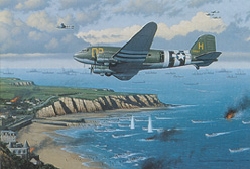|
|
| D-Day Invaders |
|
 |

|
 |
|
|
| DESCRIPTION |
 |
| 16 x 11.5 Inch Collector Size Unframed Lithograph $40.00
"You are about to embark on the Great Crusade toward which we have striven these many months. The eyes of the world are upon you. The hopes and prayers of liberty-loving people everywhere march with you. In company with our brave Allies and brothers-in-arms on other fronts you will bring the destruction of the German war machine the elimination of Nazi tyranny over the oppressed peoples of Europe and security for ourselves in a free world." These were the final words of Supreme Commander Eisenhower to the huge force assembled in June of 1944 on the eve of D-Day. Parachute infantry units would play an important role on D-Day. Although Billy Mitchell had contemplated forming airborne military forces during WW I it was not until May of 1939 that the United States commenced a study regarding the feasibility of creating an air infantry. By 1940 an all-volunteer test platoon had been organized at Ft. Benning Georgia. As the threat of War continued the Army began experimenting with gliders in mid-1941. After the attack on Pearl Harbor the Army established Parachute Infantry Battalions and by early 1943 an Airborne Command was organized as well as an Air Transport Command to facilitate the training of air crews necessary for the deployment of airborne forces. By mid-1942 authorization was received to form two airborne divisions the 82nd and the 101st. With a strength of about 8000 men these divisions were about half the normal strength of an infantry division. The first major test for America's new airborne forces came in North Africa during operation TORCH where the 1st Battalion of the 503rd Infantry was deployed. The 82nd Airborne was later successfully deployed during the invasion of Sicily. Operation OVERLORD the code name for the D-Day invasion included both of America's Airborne Divisions as well as the British 6th Airborne Division. The plan called for numerous parachute jumps and glider landings during the evening prior to the invasion. Supplemental jumps or landings would take place later during daylight hours to reinforce these troops and bring in supplies. Although eighteen aircraft were utilized as pathfinders the evening jumps were highly scattered and off target in many cases. Despite the massive difficulty in reassembling the troops of the 101st and 82nd performed their missions with distinction. By June 9 nearly all airborne objectives had been secured despite heavy casualties. Both the 101st and the 82nd each lost about 1200 men killed-in-action. By occupying German forces behind the invasion front these airborne forces saved the lives of many on the beaches at Normandy. The 101st and 82nd Divisions continued fighting until mid-July when they were pulled back to England. During these hectic weeks of fighting casualty rates were in excess of 50%. As depicted in Stan Stokes painting which is dedicated to all those who participated in the "Great Crusade" a C-47 "Skytrain" (bearing white and black invasion stripes) passes over the beaches of Normandy following a drop behind enemy lines on June 6 1944 |
|


|